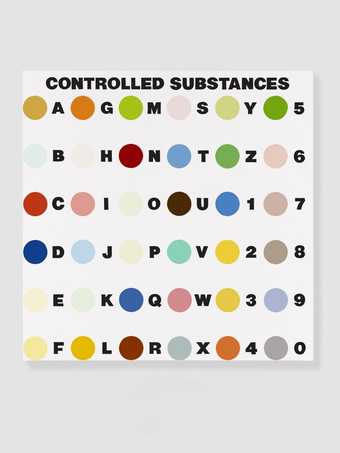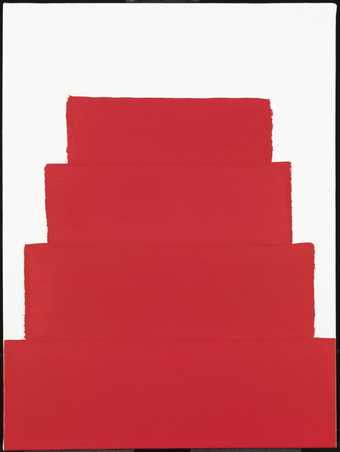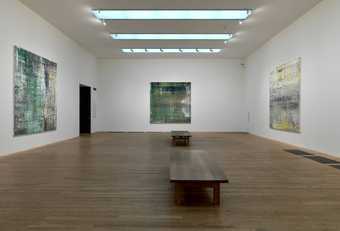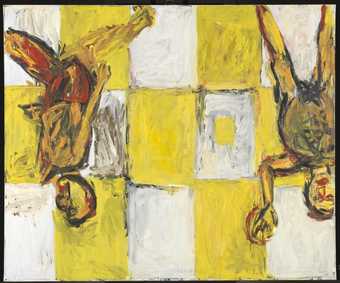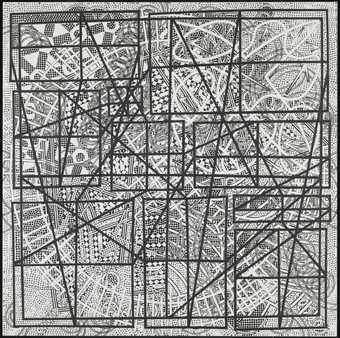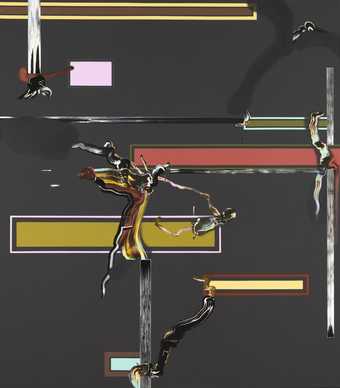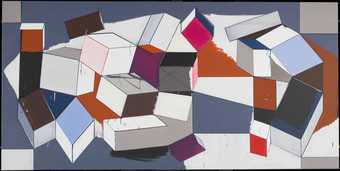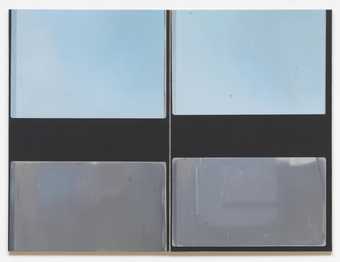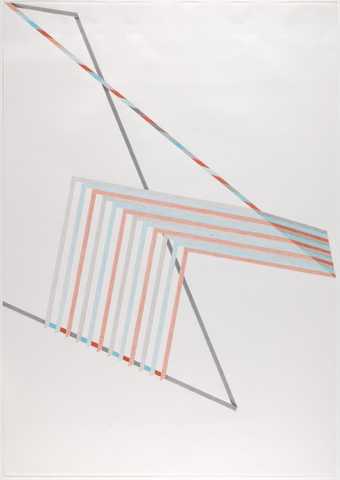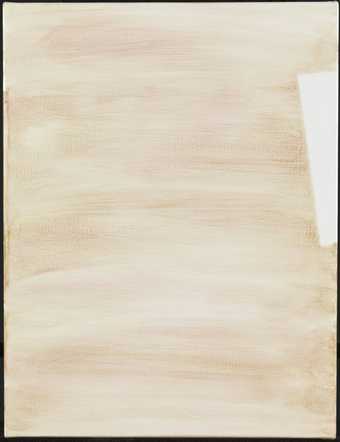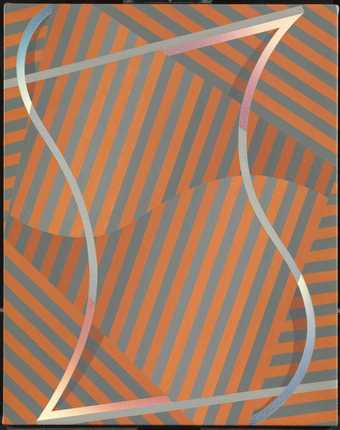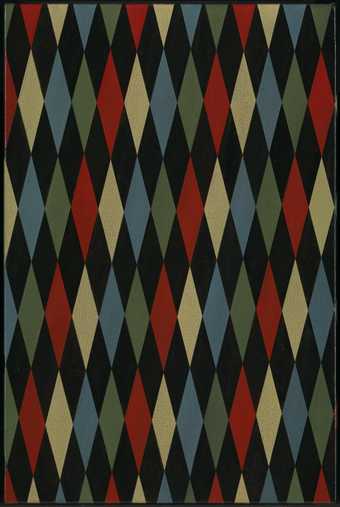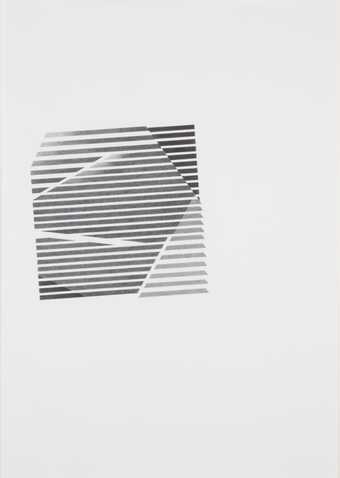
Not on display
- Artist
- Tomma Abts born 1967
- Medium
- Oil paint and acrylic paint on canvas
- Dimensions
- Support: 480 × 380 mm
- Collection
- Tate
- Acquisition
- Purchased 2006
- Reference
- T12275
Summary
In Noeme 2004 red and blue lines form circular shapes that, where they intersect and seemingly overlap each other, create the suggestion of three-dimensional forms in space. The subtle modulation of the lines also evokes a play of light within the pictorial space, though the imagery – distantly suggestive of atomic or astronomical diagrams – remains resolutely nonfigurative.
Since 1998 the German-born and London-based artist Tomma Abts has worked with the same sized canvas, measuring forty-eight by thirty-eight centimetres. To make paintings such as Noeme she covers the surface of the small canvas (which she props on a lectern or cradles in one arm) with layers of paint until she finds the forms with which she wants to work. Abts often returns to her paintings over a period of time, carefully working and reworking their surfaces. Frequently the underlying colours remain visible, glimpsed through later layers of paint.
Abts has claimed that she wants to produce an art devoid of all symbolism, and that she wants her paintings to be encountered in their own right, with no hidden imagery or meaning to be discovered. As she explained in a 2004 conversation with the painter Peter Doig, ‘the forms don’t stand for anything else, they don’t symbolise anything or describe anything outside of the painting. They represent themselves’ (‘Peter Doig/Tomma Abts’, in Tomma Abts, exhibition catalogue, Galerie Daniel Buchholz, Cologne 2006, p.14). In common with many abstract artists, her choice of title does not seek to ‘explain’ the work. Noeme, like the titles of all her other paintings, was selected from a German dictionary of first names.
In recent years a renewed interest in painting among contemporary artists and critics has led to debates around the continuing possibilities and viability of painting in the twenty-first century. Art historian David Joselit has argued that the best contemporary painting avoids being stuck as an outmoded form through its engagement with a range of ‘transitive’ networks, where the painting’s meaning, form, materials and status remain open to change within each new situation (David Joselit, ‘Painting Beside Itself’, October, no.130, Fall 2009, pp.125–34). Tate curator Mark Godfrey has suggested that a viewer may recognise ‘the networked world’ in Abts’s paintings, but that her meditative work also offers painting as ‘an alternative realm’ to ‘ceaseless networking, communicating, and passage’. While many of Abts’s compositions are, like Noeme, ‘based on nodes, vectors, arrows that seem to form diagrams or networks’, it is indicative, he has written, ‘that the lines break apart or only connect to themselves’ (Mark Godfrey, ‘Tomma Abts’, in Wilson 2013, pp.11–17).
Noeme was displayed as part of Abts’s solo show at Kunsthalle Basel, Switzerland, in 2005. On the strength of that show, and an exhibition at Greengrassi in London, she was nominated for, and subsequently won, the 2006 Turner Prize, awarded annually to an artist under the age of fifty working in Britain. In 2006 Noeme became the first painting by Abts to be acquired by Tate, and in 2008 it appeared at her first solo show in the United States at the New Museum of Contemporary Art, New York.
Further reading
Suzanne Hudson, ‘The Best Laid Plans: On Accidentally Not Reading Tomma Abts’, Parkett, no.84, 2008, pp.18–23.
Tomma Abts, exhibition catalogue, New Museum of Contemporary Art, New York 2008, reproduced p.79.
Andrew Wilson (ed.), Painting Now: Five Contemporary Artists, exhibition catalogue, Tate Britain, London 2013, pp.10–25, reproduced p.16.
Jo Applin
February 2014
Supported by Christie’s.
Does this text contain inaccurate information or language that you feel we should improve or change? We would like to hear from you.
Display caption
The ambiguous nature of Tomma Abts’s paintings questions traditional distinctions between abstraction and representation. In her works paint is thickly applied in places, creating ridge-like reliefs which at times she emphasises with trompe l’oeil shadow. Through over-painting and illusion she reverses the early Modernist aim of making the painting process more apparent. Abts’s forms often begin to take on figurative qualities. In Noeme (2004), the interlocking linear elements suggest planets or their halos.
Gallery label, May 2007
Does this text contain inaccurate information or language that you feel we should improve or change? We would like to hear from you.
Explore
- abstraction(8,615)
-
- non-representational(6,161)
-
- geometric(3,072)
You might like
-
Damien Hirst Controlled Substance Key Painting
1994 -
Martin Creed Work No. 1102
2011 -
Gerhard Richter Cage (1) - (6)
2006 -
Georg Baselitz Adieu
1982 -
John McLean Opening
1987 -
Bernard Cohen Out There
1994–5 -
Fiona Rae Night Vision
1998 -
Jean Spencer [no title]
1997 -
Thomas Scheibitz 90 Elements
2007 -
Eberhard Havekost Infinity 1 and 2
2008 -
Tomma Abts Untitled no. 6
2008 -
Robert Holyhead Untitled
2010 -
Tomma Abts Zebe
2010 -
Gillian Carnegie Untitled
2008 -
Tomma Abts Untitled #4
2014

